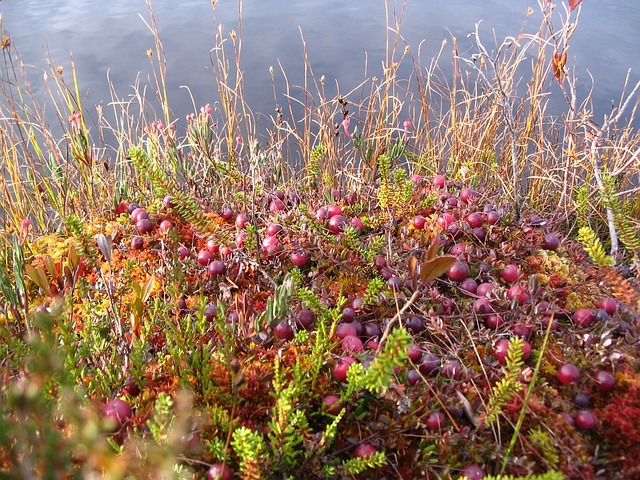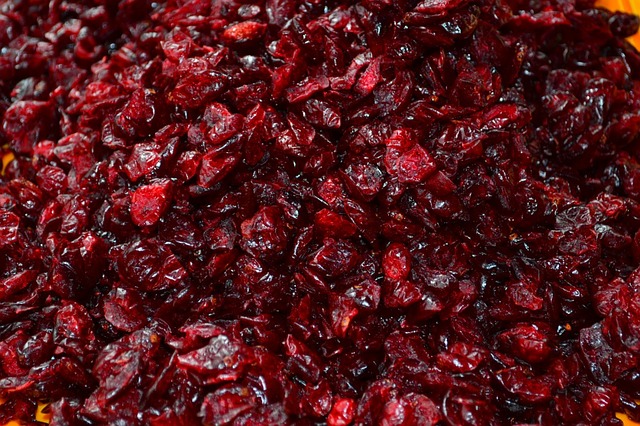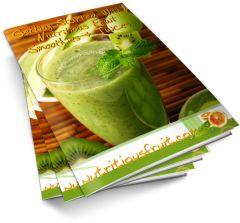Cranberry: Origins - Consumption - Nutrition Facts - Health Benefits
|
|
|
Contents
- Geographic origin and regions grown
- History of consumption
- Common consumption today
- Nutrition Facts: Vitamins, minerals and phytochemical components
- Health Benefits: Medicinal uses based on scientific studies
- Bibliography
Geographic Origins and Regions Grown

Cranberries are low, creeping shrubs or vines found in acidic bogs throughout the cooler parts of the Northern Hemisphere. The flowers are dark pink, with very unique reflexed petals that leave the style and stamens completely exposed and pointing forward.
The berry is larger than the leaves of the plant, and while it starts out white, it becomes deep red in color when fully ripe. The acidic taste of the berry can overwhelm its sweetness when eaten raw.
History of Consumption
Cranberries are usually made into products such as juice, sauce, sweetened dried cranberries, or canned as a means of preservation with the rest being sold fresh to consumers. Cranberry sauce is considered an essential part of traditional American and Canadian Thanksgiving menus and European winter festivals.
Common Consumption Today
The use and consumption of the cranberry has not significantly changed over the years with most people consuming the largest amounts of fresh or canned cranberry sauce in a jellied or whole berry form during the Thanksgiving and Christmas holidays.
Cranberry juice is more regularly consumed by individuals that consider the cranberry to be a potent free radical scavenger (antioxidant) of the blood and as a means of treating urinary tract infections.
In a more global sense, the food industry considers the nutrient content and antioxidant properties of the cranberry a sufficient reason to give cranberries the commercial status of being a novel "superfruit."
Nutrition Facts: Vitamins, Minerals and Phytochemical Components

Cranberries are a source of polyphenol antioxidants, which are phytochemicals being currently researched for its possible beneficial effects of the cardiovascular system, immune system, and as anticarcinogenic properties.
Cranberries are a particularly rich source of phenolic phytochemicals that include: phenolic acids (benzoic, hydroxycinnamic, and ellagic acids) and flavonoids (anthocyanins, flavonols, and flavan-3-ols) (1).
Cranberry seed oil has been found to contain higher levels of tocotrienols than any other fruits. Tocotrienol is an antioxidant composed of vitamin E that stabilizes cell membranes, regulates oxidative stress, and protects polyunsaturated fatty acids and vitamin A from free radical damage (2).
Health Benefits: Medicinal Uses Based on Scientific Studies
Current research shows that the cranberry is beneficial for the treatment of urinary tract bacterial infections (3). Studies suggest that a component of the juice competitively inhibits bacterial attachment to the bladder and urethra, which allows the bacteria to be flushed out more easily.
Recent studies have been performed where cranberry was administered in a capsule form to patients suffering from urinary tract infections. The results showed that the cranberry has antibacterial properties that lead to the inhibition of Escherichia coli (E. coli) infections by reducing the bacteria’s ability to attach itself to cells. This study also suggests that the consumption of cranberry juice may be an effective treatment for urinary tract infections (4).

Cranberry juice also contains a chemical component made up of a high molecular weight non-dializable material (NDM), that can inhibit and even reverse plaque formation from Streptococcus mutan bacteria that cause tooth decay and other oral bacteria that cause gingivitis.
Raw cranberries are the most plentiful source of the anthocyanidin flavonoid peonidin, and they are also rich in two other anthocyanidins, cyanidin and petunidin.
Although these anthocyanidins are unusually powerful at inhibiting and even killing many kinds of human cancer cells in laboratory studies, when ingested by humans their effect is unproven and significant questions about their success are raised by their poor absorption into somatic cells and their rapid elimination from the bloodstream. Cranberries also contain tannins, which have anti-clotting properties.
Current evidence also shows that polyphenols found in cranberries may reduce the risk of developing cardiovascular disease by increasing the resistance of low-density lipoprotein (LDL), known as bad cholesterol, to oxidation, inhibiting platelet aggregation, reducing blood pressure, and by having anti-thrombotic and anti-inflammatory effects on the body (1).

Bibliography
1. Cranberry health research summary. (2000) International Conference and Exhibit on Nutraceuticals and Functional Foods. University of Massachusetts-Amherst. Retrieved on January 24 2008 from http://www.cranberryinstitute.org/news/pr/pr022001.htm
2. Dugoua JJ, Seely D, Perri D, Mills E, Koren G. (2008) Safety and efficacy of cranberry (vaccinium macrocarpon) during pregnancy and lactation. The Canadian Journal of Clinical Pharmacology, 15(1):e80-6.
3. Lavigne JP, Bourg G, Combescure C, Botto H, Sotto A. (2008) In-vitro and in-vivo evidence of dose-dependent decrease of uropathogenic Escherichia coli virulence after consumption of commercial Vaccinium macrocarpon (cranberry) capsules. Clinical Microbiology and Infection, 2008 Jan 7 [Epub ahead of print]
4. McKay DL, Blumberg JB. (2007) Cranberries (Vaccinium macrocarpon) and cardiovascular disease risk factors. Nutrition Reviews, 65(11):490-502.
Disclaimer
Nutritiousfruit.com provides this website as a service. Although the information contained within the website is periodically updated, no guarantee is given that the information provided is correct, complete, and/or up-to-date. The materials contained on this website are provided for general information purposes only and do not constitute legal or other professional advice on any subject matter. Nutrtiousfruit.com does not accept any responsibility for any loss, which may arise from reliance on information contained on this website. The information and references in this website are intended solely for the general information for the reader. The content of this website are not intended to offer personal medical advice, diagnose health problems or to be used for treatment purposes. It is not a substitute for medical care provided by a licensed and qualified health professional. Please consult your health care provider for any advice on medications.
Didn't find what you were looking for? Search here...

Amazon Search Box:
Did you like this page?
|
|
|




